5 Ways to Remove Coffee Stains From Your Teeth
Wondering how to remove coffee stains from your teeth? Don’t worry I’m not going to tell you to skip your morning brew. Instead, use these natural alternatives and tips to get your dazzling smile back.

This post contains affiliate links. Please read my affiliate disclosure.
Although I love my morning cup of coffee, I do not love the pesky coffee stains it leaves behind. Thankfully, I have found that removing coffee stains from teeth can be done at home and on a budget. Better yet, these methods allow you to say goodbye to discoloration without damaging tooth enamel and without using harsh chemicals.
As well as covering how to remove coffee stains from teeth, I’ll delve into other causes of tooth discoloration as well as ways to drink coffee to avoid those confidence crushing surface stains.
Whether you’re fed up of hiding your teeth when you smile or simply want your confidence back, these are the best tips and tricks to try.
I’m not a doctor or health care professional, and this is not medical advice. This post is for educational purposes only, and you should follow up with your doctor for more information.
Why Does Coffee Stain Teeth?
Although we avid coffee drinkers know coffee stains teeth, rarely do we know the reason why. Coffee contains substances called tannins and chromogens. Tannins are plant compounds that can stick to the surface of your teeth, while chromogens are pigments that can easily attach to your tooth enamel.
This means that after you enjoy your cup of coffee, these compounds leave behind a residue on your teeth, leading to discoloration over time. Additionally, coffee is acidic, which can weaken the protective outer layer of your teeth, making them more susceptible to staining. This means double trouble for your oral health. The combination of these compounds and the acidity of coffee can gradually cause the yellow stains we commonly associate with coffee-drinking.

What are the best ways to remove coffee stains from teeth?
1. Whitening Toothpaste
Let’s start with the easiest, most affordable solution for removing coffee stains from teeth – whitening toothpaste. Although there are so many to choose from, I recommend you opt for a natural toothpaste without fluoride. My favorites include Thieves Whitening Toothpaste or a whitening charcoal toothpaste.
Natural toothpaste usually contains gentle yet effective ingredients such as baking soda, activated charcoal, or hydrogen peroxide. These can help lift and remove surface stains without harsh chemicals.
Natural toothpaste also typically avoids the use of fluoride. Like many people, I try to limit my fluoride intake (one of the many reasons I use a Berkey water filter.) I find using a natural toothpaste is one of the easiest ways to do this. While fluoride is known for its benefits in preventing tooth decay, excessive exposure may lead to fluorosis which is a condition that causes white spots or discoloration on teeth. By opting for fluoride-free toothpaste, you have more control over the amount of fluoride you consume.
Lastly, natural toothpaste often contains botanical extracts like peppermint, spearmint, or tea tree oil. These help to freshen your breath and provide a pleasant taste without synthetic additives or artificial flavors.
It’s important to note that while natural toothpaste can be effective for removing surface stains, deeper or more stubborn stains may require professional dental treatments or some of my other suggestions below.
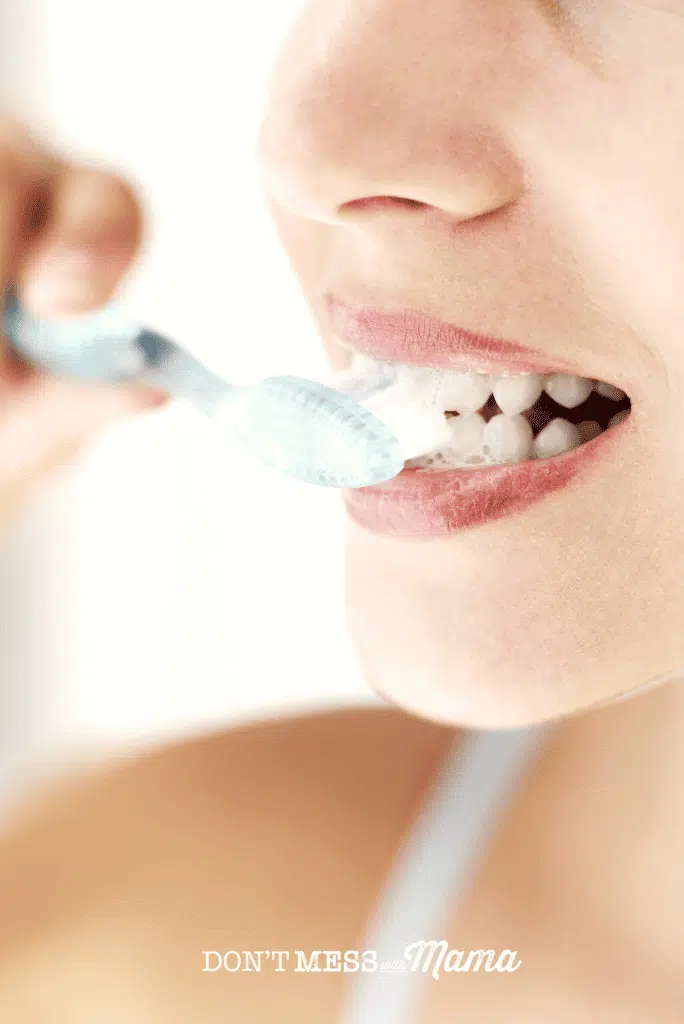
2. Good Oral Hygiene
On the topic of toothpaste, you can have the best, whitening toothpaste on the planet but it will have minimal impact if you a) don’t use it daily and b) don’t use it with the correct tools. One of the most effective ways to remove coffee stains from teeth is staying on top of good oral hygiene.
This means not only choosing a good, natural toothpaste but using it with an electric toothbrush. Also, don’t forget to floss and use a Waterpik to protect those pearly whites. Regular dental check-ups and cleanings are also essential for maintaining optimal oral health and addressing any persistent staining concerns. While some of these items may sound like an investment, I can promise it’s far easier and cheaper to prevent coffee stains from building up rather than treating them later. As well as a good routine and regular check-ups you may want to consider getting cleanings every 4 months instead of every 6 months. This will help to remove coffee stains from teeth before they get too stubborn.
3. Whitening Strips
I don’t think a day goes past when I don’t see an advert online for whitening strips. There are SO many on the market, so how do you know which ones are safe? While the majority do work at removing coffee stains from teeth, they contain bleaching agents which can damage tooth enamel if used excessively.
That’s why I prefer non-toxic Lumineaux whitening strips. Not only are they great for sensitive teeth, but they help to lift surface stains without damaging tooth enamel. They’re packed with ingredients that can nourish and improve your oral health without preservatives, additives, artificial dyes or flavorings.
When using tooth whitening strips, it’s crucial to follow the instructions provided by the manufacturer. Limit usage to the recommended time frame and frequency. This will ensure your natural whiteness is restored, without damage to your tooth structure.
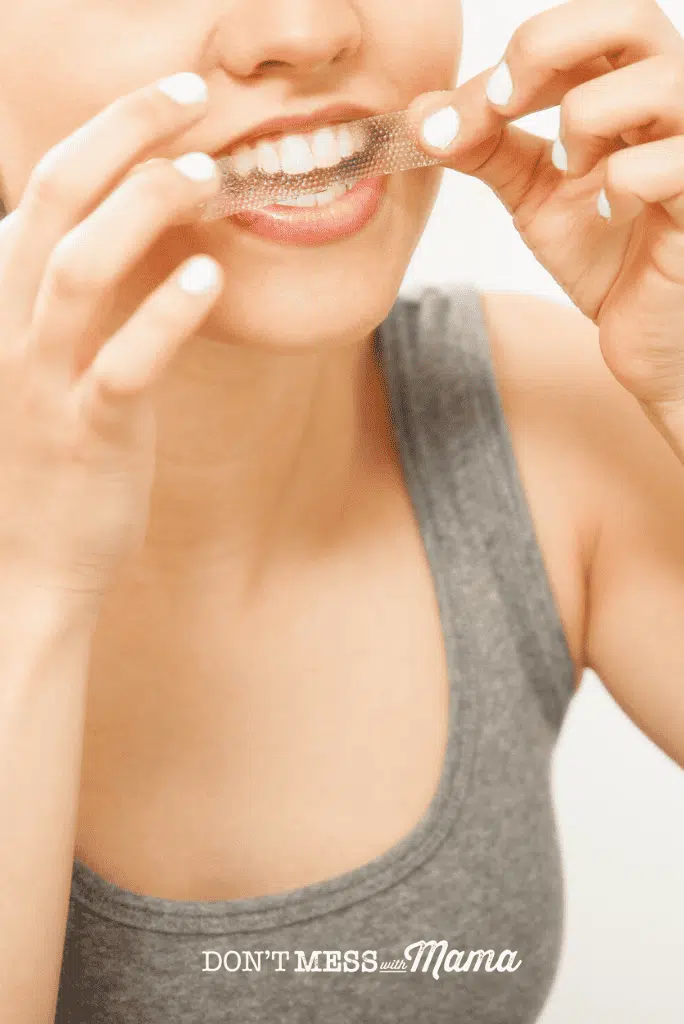
4. Teeth Whitening Kits
Heavy coffee drinkers may prefer to opt for a teeth-whitening kit for a few reasons. Firstly they typically come with custom-fitted trays that are molded to fit your teeth. This allows a more precise and even application of the whitening gel which can sometimes be a struggle with whitening strips.
Secondly, they sometimes also come with different concentrations of gel. This means you can tailor the treatment depending on the severity of the surface stains. Some people start with a low concentration and then gradually increase to minimize sensitivity.
My go-to, teeth whitening kit is Primal Life Organics LED teeth whitening system. This is because it utilizes both blue light and red light technology. When exposed to blue light, the whitening gel is activated, speeding up the whitening process. Meanwhile the red light is used to help reduce tooth sensitivity and promote gum health. Red light can also stimulate blood circulation and promote tissue repair, providing a soothing and comforting effect on the gums.
Overall, I find this combination has a longer lasting result in comparison to teeth whitening strips. While teeth whitening strips are great for a temporary fix, a kit allows for a more thorough treatment.
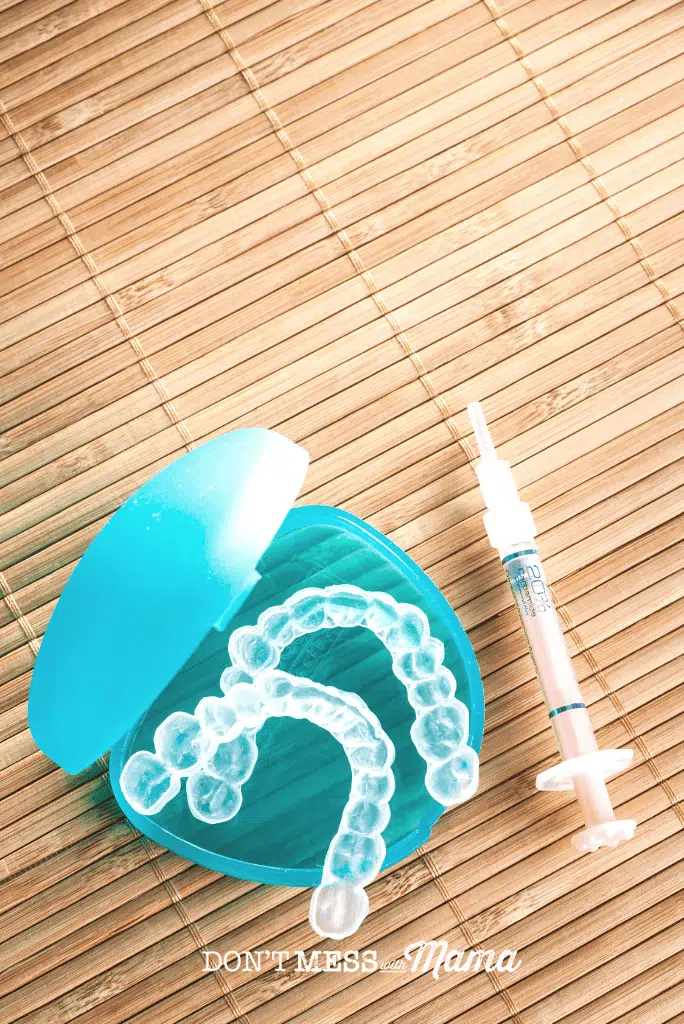
5. Professional Whitening Treatment
While at home whitening kits are convenient and affordable, they are more suitable for gradual stain removal. If you want a fast solution or you’re a heavy coffee drinker with stubborn staining, then seeking professional treatment is likely the best option.
Professional teeth whitening treatments offer a higher level of customization, stronger whitening agents, and faster results due to dental supervision. The dentist will assess your oral health then determines the most appropriate whitening method. This ensures optimal results with minimal sensitivity.
If it’s possible, I recommend asking your dentist about Zoom teeth whitening. This procedure includes a hydrogen peroxide based whitening gel and Zoom light to whiten teeth. In addition to the initial Zoom whitening procedure, you usually receive a set of customized trays for touch-ups and maintenance.
Some people may also prefer this method to remove coffee stains as you benefit from the expertise and guidance of a dental professional. They monitor the treatment, ensure proper technique and safety, and address any concerns or complications that may arise.
While it’s more expensive, it is more likely to have noticeable improvements after a single session. Whereas at home kits may take a few sessions, potentially costing you more. I recommend consulting with your dentist to help determine the most suitable option for removing coffee stains. This will ensure safety and the best option for your oral health.
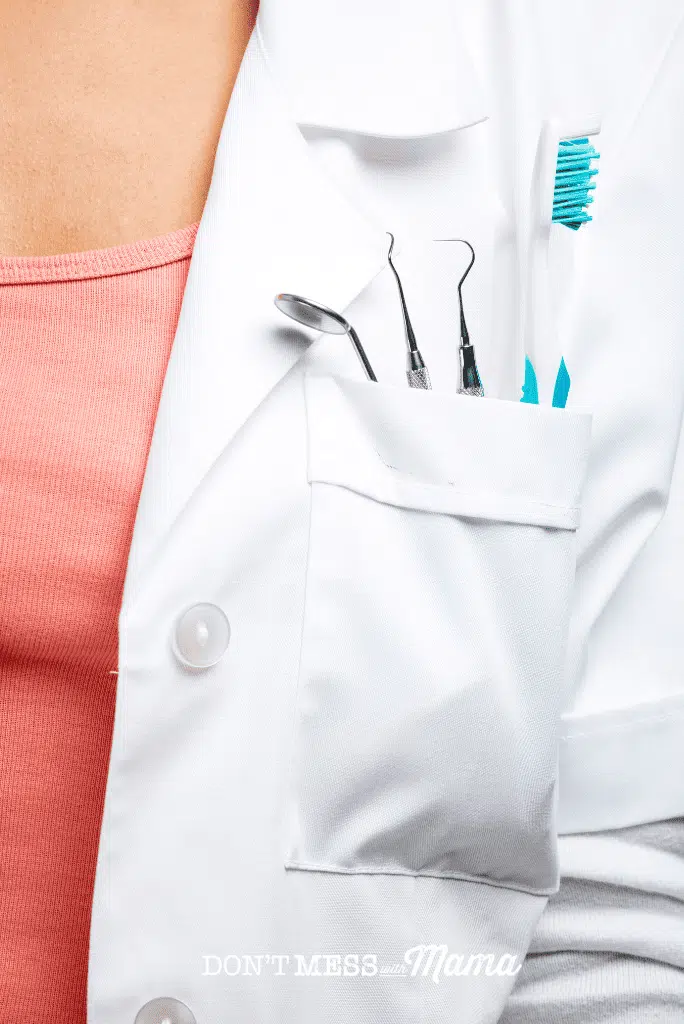
Are there natural remedies to remove coffee stains from teeth?
As well as a natural toothpaste there are a few natural remedies I swear by to help remove coffee stains from teeth. These can be done using ingredients found in your home saving you money and effort.
- Brushing with baking soda
Over the years I’ve found 30+uses for baking soda in my home, including helping to brighten my smile. Not only is baking soda mildly abrasive but it has an alkaline pH. This helps helps neutralize acids in the mouth that can contribute to tooth discoloration. In a study, researchers found that brushing with baking soda is effective for stain removal on teeth. Use it once a week by adding a sprinkle of baking soda to a wet toothbrush and brush for two minutes. I do not recommend using it more than once a week to minimize any potential enamel abrasion. - Brushing with baking soda and hydrogen peroxide
Not only does hydrogen peroxide have so many uses, but it is natural and environmentally friendly. While baking soda’s mild abrasive properties help to scrub away surface stains, hydrogen peroxide is a mild bleaching agent. It helps to dissolve stains, revealing a brighter smile. Again, use it in moderation (ideally, no more than twice a month.) Mix a few drops of hydrogen peroxide with a pinch of baking soda and apply to toothbrush. Brush teeth for two minutes, rinse thoroughly and make sure not to swallow any mixture. - Oil pulling with coconut oil
From cleaning to cooking, I use coconut oil almost daily. When it comes to a brighter smile, I recommend using coconut oil for oil pulling. Simply swish the oil in your mouth for around 20 minutes before spitting it out into the trash or toilet. Oil pulling has many benefits, including removing plaque, which may contribute to bad breath and staining. - Activated charcoal
Toothpaste with activated charcoal has become increasingly popular. But you can also just add activated charcoal to your regular toothpaste and use it to brush your teeth. It’s a great way to use for activated charcoal. Researchers have found that while activated charcoal does have a whitening effect on teeth, it is more abrasive compared to other whitening options like baking soda. To use it, wet your toothbrush and gently dab it into a container of activated charcoal. Brush your teeth as you usually would and let the mixture sit on your teeth for a few minutes. Then rinse and brush your teeth with regular toothpaste. Do this two to three times a week.
What natural teeth whitening methods should you avoid?
Lemon juice and strawberries are often celebrated as natural teeth whiteners due to their acidic nature. However, they are a little too acidic so can erode tooth enamel. Not only can this lead to tooth sensitivity but also risk cavities. Using lemon juice or strawberries directly on your teeth can do more harm than good, so it’s best to stick to my methods above for removing coffee stains on teeth.
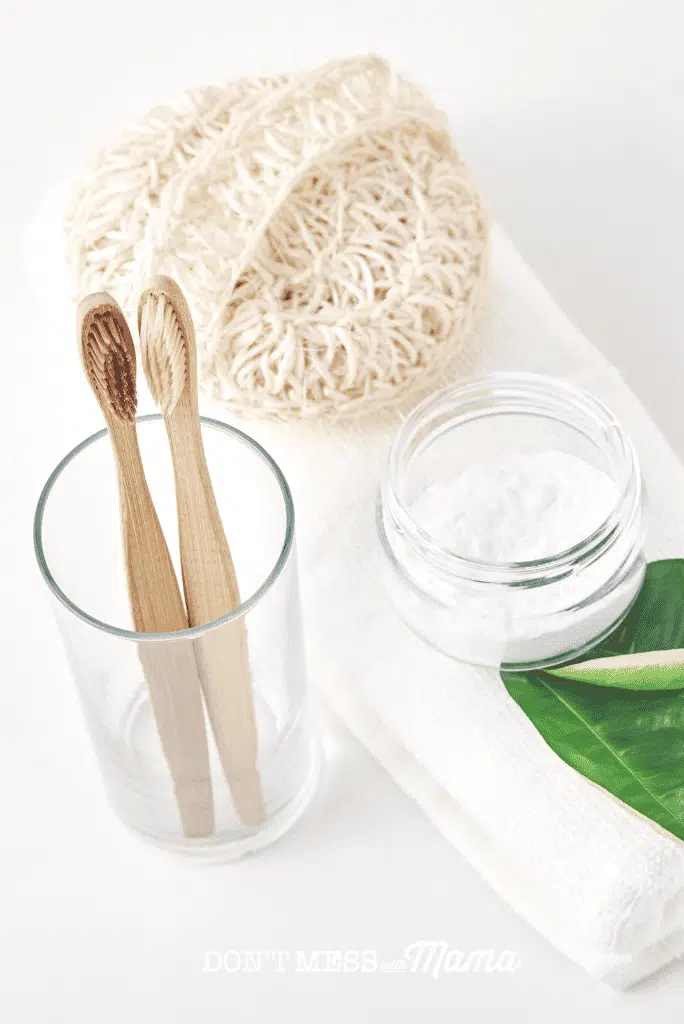
How to drink coffee without staining teeth
Prevention is always easier than cure. So if you’re a coffee lover but want to minimize the staining effects on your teeth, here are some tips to enjoy your coffee while reducing the potential for tooth discoloration:
- Use a Straw: Sipping coffee through a straw can help minimize direct contact between the coffee and your teeth. By bypassing the front surface of your teeth, you can reduce the exposure of your tooth enamel to the staining compounds in coffee.
- Brush After Drinking Coffee: Brushing your teeth after drinking coffee can help prevent them surface stains from settling in. Wait for at least 30 minutes after drinking coffee before brushing. This is because the acidic nature of coffee can temporarily soften the enamel so immediate brushing may lead to enamel erosion. Use a soft-bristled toothbrush and fluoride-free toothpaste to gently clean your teeth.
- Rinse After Drinking Coffee: If brushing isn’t immediately possible, rinsing your mouth with water can still help. Swish water around your mouth to wash away any coffee residue and minimize its contact with your teeth. This can help reduce the chances of staining until you can brush your teeth properly.
- Add Milk or Cream to Your Coffee: Adding milk or cream to your coffee can help dilute the staining properties of coffee. The proteins present in milk can bind to the tannins found in coffee, reducing their ability to stain your teeth. Additionally, lightening the color of your coffee with milk or cream can make the overall staining less noticeable. New to creamer? Try my irresistible pumpkin spice coffee creamer.
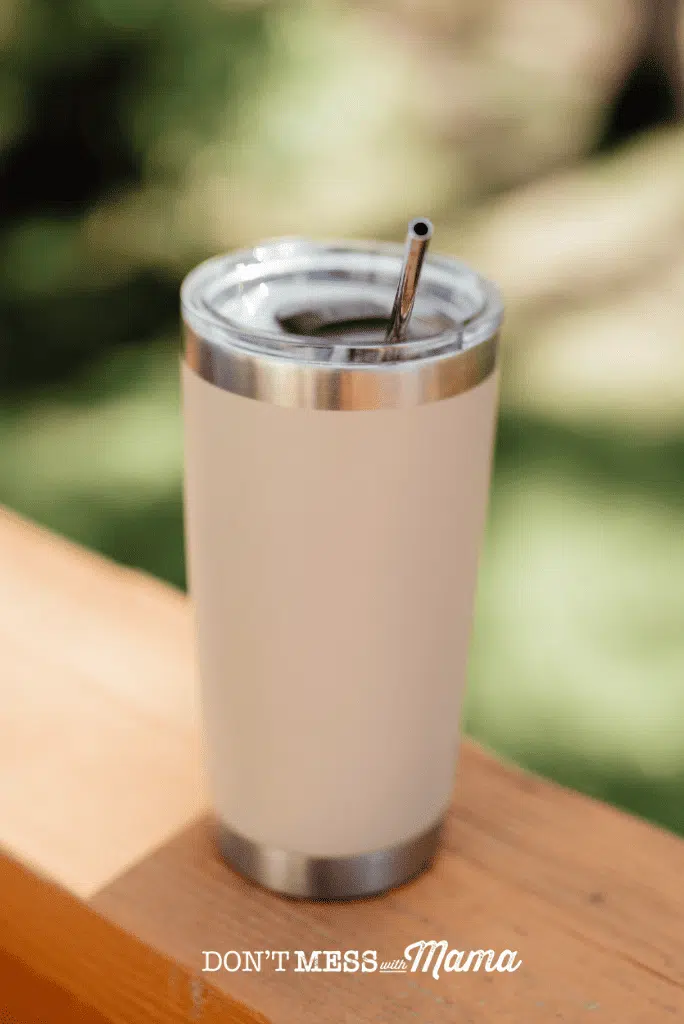
What other foods and drinks stain teeth?
If you have tried the methods above, and find that your bright smile still hasn’t returned it could be something else in your diet causing the staining.
- Tea: similar to coffee, tea also contains tannins that can lead to teeth discoloration.
- Soda: carbonated sodas (Especially dark-colored like cola) contain artificial colors and high levels of sugar and acids which erode tooth enamel.
- Red wine: Like coffee, red wine also contains those dark colored compounds called chromogens. Additionally, the acidity in wine can weaken enamel, risking staining.
- Sports drinks: Traditionally sports drinks contain high sugars and acids which make teeth more prone to staining. I’d recommend switching to a natural alternative, such as my homemade electrolyte drink.
- Fruit juice: Even natural colorants found in fruit juice such as grape or cranberry juice can stain teeth if consumed regularly. Fruit juice is also high in sugra which can contribute to discoloration and tooth decay.
- Berries: For example blueberries, blackberries, and raspberries have intense natural pigments that can stain teeth when consumed regularly.
- Curry: While I love the health benefits of turmeric, I recognize that it can lead to visible staining. Other curry spices that are similarly deep yellow or orange can also stick to the tooth surface causing discoloration.
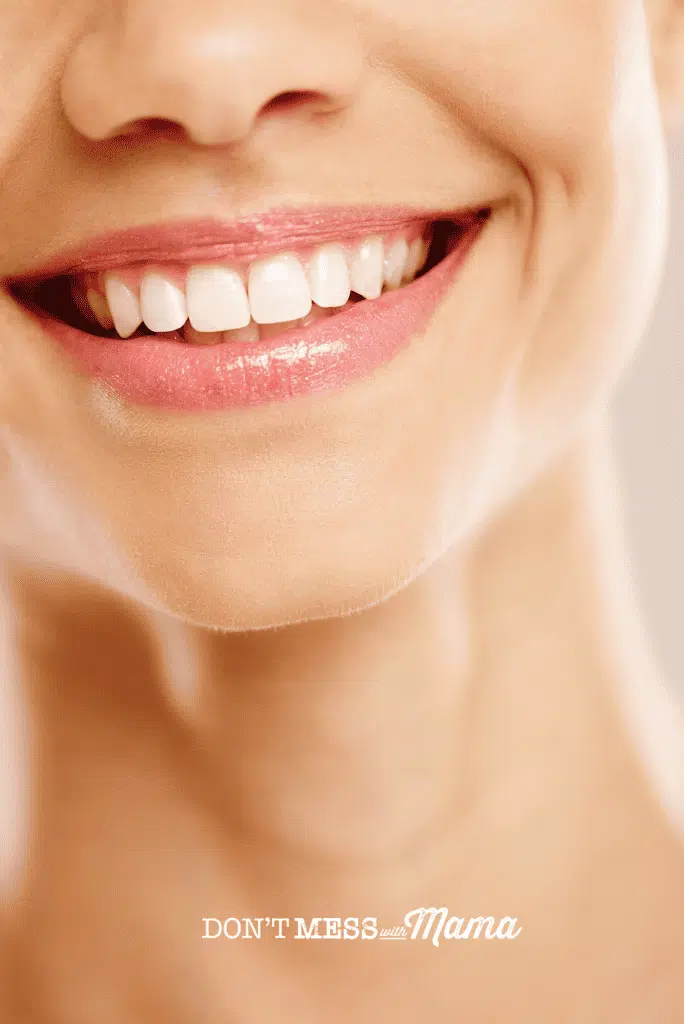
When it comes to removing coffee stains on teeth, opting for natural methods is always a favored choice for me. Harsh bleaching agents may provide quick results, but they come with potential risks to tooth enamel and sensitivity.
It’s important to note however that while these methods can help minimize staining, they are not foolproof. It’s still essential to maintain a good oral hygiene routine, including regular brushing, flossing, and dental check-ups. If you are struggling to remove stubborn coffee stains, a professional cleaning by a dental hygienist may be the best option.
Before you pick up your next morning coffee, keep my tips in mind such as using a straw, brushing afterwards or adding milk to minimize staining. By prioritizing prevention over cure, you can enjoy your coffee without compromising the beauty of your teeth.
More Posts You Might Like
- 5 Health Benefits of Collagen Powder
- 7 Surprising Benefits of Cod Liver Oil
- 8 Signs of Magnesium Deficiency + Natural Ways to Boost Magnesium
Did you try these methods to get rid of coffee stains on teeth? Don’t forget to comment below to let me know how it went. You can also FOLLOW ME on Facebook, Instagram and Pinterest.
Sources:
• https://www.healthline.com/health/dental-and-oral-health/what-does-coffee-do-to-your-teeth
• https://www.webmd.com/oral-health/guide/tooth-discoloration
• https://www.medicalnewstoday.com/articles/321480
